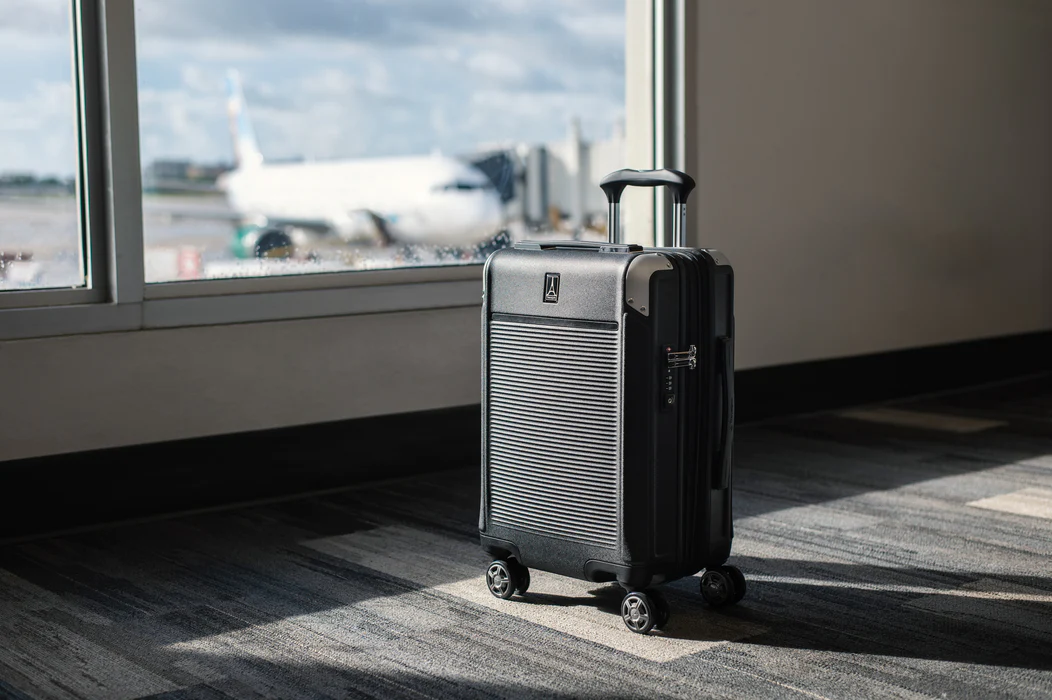Are you ready to embark on an exciting international adventure? Well, before you jet off, let’s talk about the unsung hero of travel – the carry-on luggage. We all know the struggle of deciding what to pack and what to leave behind, especially when it comes to those pesky airline restrictions. But fear not, fellow globetrotters! In this detailed packing list, we’ll reveal the ultimate secrets to packing your carry-on like a pro for an international flight. So grab your passport, buckle up, and get ready to conquer the world, one perfectly packed carry-on at a time!
Carry-on vs Checked Luggage – Unravelling the Differences

carry on bag
Imagine you’re preparing for an international voyage. You’re faced with a wide range of luggage options. The choice can be overwhelming, but understanding the difference between carry-on and checked luggage can make all the difference.
A carry-on bag is a traveller’s best friend. It’s the suitcase or backpack that you can carry onto the aircraft with you. These bags find their home in the overhead lockers or nestled comfortably under your seat, always within reach. However, they are bound by certain restrictions concerning their contents, weight, and size. You’ll need to pack smart to make the most out of your carry-on luggage.
Read all about: Jump into the Heart-Pumping Adventure of Bungee Jumping in Texas: A Guide to Safety, Pricing, and Hours of Operation
On the flip side, checked luggage doesn’t stay with you during the flight. Instead, it’s stowed away safely in the plane’s cargo area. These are the larger bags that wouldn’t fit in the cabin. Although these bags come with a fee, they offer more space for those extra items you might want to pack for your trip.
It’s important to remember, though, that not all airlines define carry-on and hand luggage in the same way. Some airlines consider a carry-on to be a smaller suitcase or backpack, while the term hand luggage is reserved for a petite handbag or bumbag.
| Type of Luggage | Description | Location during Flight | Size and Weight Limitations |
|---|---|---|---|
| Carry-on | A smaller suitcase or backpack that travellers carry onto the airplane | Overhead lockers or under plane seats | Subject to airline-specific restrictions |
| Checked | Larger luggage items transported in the plane’s cargo area | Plane’s cargo area | Larger size and weight allowances, but subject to fees |
| Hand Luggage | Typically a small handbag or bumbag | With the passenger | Very limited size and weight |
Unveiling the Rules for Carry-on Luggage in Australia – Domestic and International Flights
When it comes to air travel in Australia, the rules of the sky aren’t always clear cut. Each airline wields the power to determine the size and weight of the carry-on luggage they permit onboard. This flexibility allows them to ensure a fair distribution of weight and space for every passenger. However, these dimensions can vary significantly between different Australian airlines. Even within the same airline, the ticket class can influence your carry-on allowance, with pricier tickets often commanding a larger luggage capacity. Let’s unfold these restrictions in detail.
Qantas – The Sky’s the Limit?
Renowned for its kangaroo logo, Qantas has carefully crafted rules regarding the dimensions and weight of carry-on luggage. These vary depending on your ticket class. If you’re luxuriating in First, Business, or Premium Economy, you can carry either 1 bag of 115cm dimensions (56cm + 36cm + 23cm) or 2 bags of 105cm each (48cm + 34cm + 23cm). The weight limit here is up to 10kgs for one bag or 14kgs in total. For Economy travellers, the dimensions are slightly different: you are allowed 1 x 115cm bag (56cm + 36cm + 23cm) or 1 x 185cm non-rigid garment bag (60cm + 11cm + 114cm). The weight limit drops to up to 7kgs in total.
Virgin Australia – A Compact Approach to Carry-On
Next, let’s glide over to Virgin Australia. Their carry-on baggage rules are more straightforward. No matter your ticket class, you’re allowed luggage with dimensions of 56cm long, 36cm wide, 23cm deep, and a weight of up to 7kg. It’s a simpler approach that offers consistency for travellers.
Jet Star – The Strict Steward of the Skies
Our final stop is Jet Star. Known for its stricter policies, Jet Star keeps a close eye on your carry-on luggage dimensions and weight. It’s important to note that any deviation from these specified parameters could incur additional charges. For Economy Starter, Starter Plus, and Starter Max passengers, a main item and a small item are allowed, with a combined weight of no more than 7kg. If you’ve opted for a Flex bundle, +7kg Extra Carry-On Baggage, or Business Class Fare, you can bring a main item and a small item with a combined weight of no more than 14kg. The main item must fit in the overhead lockers and be no larger than 56cm (height) x 36cm (width) x 23cm (depth). The small item, on the other hand, should tuck comfortably under the seat in front of you.
Knowing these restrictions can help you pack smarter and avoid unexpected fees. Remember, these rules are in place to ensure a smooth and comfortable journey for all passengers. So, the next time you’re preparing for a flight, make sure to weigh your options and your luggage!
Carry-on Packing List: Top Items to Include in Your Carry-on Luggage (For an International Flight)
Embarking on an international flight can be an exhilarating experience, but it also comes with its own unique set of challenges. One of those is packing your carry-on bag efficiently. This isn’t just about making sure you have your favourite book or a comfortable neck pillow, it’s also about ensuring you have all your essentials within easy reach. Let’s now delve into this task and create a checklist of indispensable items you need to pack for an international flight.
1. Travel Documents
First and foremost, your travel documents such as your passport, visa, and printed itineraries are paramount. Keeping these vital documents handy can save you a lot of time and stress at the airport. Consider using a travel document organizer to keep everything in one place and easy to access.
2. RFID-Blocking Sleeves for Bank Cards
In today’s digital age, protecting your personal information is more important than ever. RFID-blocking sleeves for bank cards can help safeguard your information from potential thieves. It’s a small item that provides significant peace of mind.
3. Technology and Entertainment Items
Flights can be long and sometimes tedious. Keeping yourself entertained with your favourite technology and entertainment items can make the journey far more enjoyable. Don’t forget your headphones, e-reader, tablet, or laptop, and remember to download movies, books, or games ahead of time.
4. Toiletries

toiletries
Having a small bag of toiletries like toothpaste, face wash, and any other personal hygiene products can make a huge difference in your comfort level during long haul flights. Keep in mind that any liquids or gels must be in containers of 100ml or less and packed in a clear, resealable bag.
5. Water Bottle and Snacks
Staying hydrated and nourished on your flight is crucial. Pack an empty water bottle to fill up after you’ve passed security, and consider bringing your own healthy snacks to stave off hunger.
6. Comfort and Sleep Items

comfort and sleep items
Getting some rest on your flight can make a world of difference. Consider packing comfort and sleep items like a travel pillow, eye mask, and earplugs. If you’re on a long flight, you might also want to pack a change of clothes or at least a fresh pair of underwear and socks.
7. Personal Protection Items
Finally, don’t forget your personal protection items. A good quality mask, hand sanitizer, and disinfecting wipes should be at the top of your list in our current climate.
Remember, each airline may have different carry-on rules and restrictions, so always check with your airline before packing. With this guide, you should be well on your way to having a well-packed carry-on for your next international flight.
Best Backpacks for Carry-on Luggage – Our Top 3 Recommendations
Choosing a backpack for carry-on luggage can feel like a mission, especially when you want to blend practicality and style. It’s about more than just storage space – it’s about ensuring that your travel essentials are secure and within easy reach. You’ll need a bag that’s comfortable to carry, even when you’re racing through bustling airport terminals or navigating narrow airplane aisles. With features like ventilated back panels, additional pockets, and strengthened shoulder straps, the right backpack can make an enormous difference to your travel experience. Here, we reveal our top three backpack recommendations for your carry-on luggage:
1. Lightweight Backpack: Comfort Meets Functionality
Imagine a backpack that feels feather-light yet is robust enough to secure your belongings. This particular recommendation is an ideal solution for long-distance travellers and backpackers. The backpack is made of lightweight material, designed with an adjustable torso length and a breathable back panel for unparalleled comfort. It’s like a chameleon, adapting to your body and providing the perfect fit. The material is not only light but also offers commendable durability, perfect for the rigours of travel.
2. Water-Resistant Backpack: Your All-Weather Companion
Whether you’re caught in a sudden downpour or accidentally spill your coffee, this backpack has got you covered. It’s crafted from water-resistant and durable polyester fabric, equipped with sturdy metal zippers that can withstand wear and tear. But the cherry on top is the RFID-protected internal pocket. It’s a fortress for your electronic devices and credit cards, shielding them from potential digital theft. Truly, an all-weather and all-situation companion!
3. Rip-Stop Backpack: The Indomitable
Backpacks tend to bear the brunt of our travel adventures, and they often show it. But not this one! Made from a lightweight triple-span rip-stop material, this backpack is incredibly resilient. It resists tearing and ripping, ensuring your belongings remain safe and intact. And for your comfort, it comes with an easy-to-adjust harness system and an air tech flex back panel for breathability, allowing you to carry even the heaviest loads with ease.
Read all about: Thrilling Bungee Jumping in New York: Debunking False Information and Exploring Alternative Extreme Sports Options
These top three carry-on backpacks truly bring together the best of design, comfort, and functionality. Remember, the perfect backpack for you is the one that suits your specific travel needs and preferences. So, weigh your options and make an informed decision. Happy packing!
Can Backpackers Pack a Carry-on Bag in Addition to Checked Luggage?
Indeed, the answer to this question that may be lingering in the minds of many seasoned or budding backpackers is a resounding yes. Not only can you pack a carry-on bag in addition to your checked luggage, but it also comes with a myriad of benefits that can significantly enhance your travel experience.
Picture this: You’re in the midst of an exhilarating international journey, hopping from one destination to another. Whether your journey takes you to the rugged terrains of the Australian outback, the bustling streets of Tokyo, or the tranquil beaches of Bali, you recognize the importance of keeping certain belongings within arm’s reach. In scenarios like these, a carry-on bag is not just a convenience—it becomes your trusty sidekick.
Read more about: “How to Pack a Packing Cube Efficiently: Discover 3 Genius Hacks to Maximize Space and Save Time!”
Having a carry-on bag allows you to keep essential items like your passport, travel documents, money, electronics, and any medication safely tucked away, yet easily accessible. It’s akin to a mini personal vault that you can keep under your watchful eye. This offers you peace of mind, particularly when you’re spending a substantial amount of time in and out of airports, navigating through various security checkpoints and customs controls.
Moreover, it’s not just about safety. The convenience factor is a game-changer too. Your carry-on bag can house those comfort and sleep items we previously discussed, such as a travel pillow, eye mask, and earplugs. So, even if your checked luggage goes astray or gets delayed, you still have your essentials and comfort items with you.
Thus, while it’s ultimately a personal choice, the advantages of packing a carry-on bag in addition to checked luggage are quite compelling. It’s about merging practicality with peace of mind, ensuring that your journey is as smooth and stress-free as possible.
Can You Get Away With Only Packing a Carry-on Bag for Travel?
You may find yourself questioning, “Is it truly feasible to rely solely on a carry-on bag for my journey?” Rest assured, the answer is a resounding yes. Turning to the world of minimalistic packing can not only simplify your travel experience but can also open up a whole new world of convenience and ease.
It may seem like a daunting task at first; the idea of squeezing everything you’ll need into a single, compact backpack. But with a bit of strategic packing and a focus on carrying only the essentials, it’s entirely possible—and beneficial—to travel with just a carry-on.
Remember, the key is to prioritize: Focus on essentials and light clothes, and leave the ‘just in case’ items behind.
How, you ask? Meet the art of the army roll. This is a packing technique borrowed from soldiers who need to carry a multitude of items in a limited space. By tightly rolling your clothes, you can significantly maximize the space in your carry-on bag, fitting in more items than you’d have thought possible.
Read more about: “How to Pack a Packing Cube Efficiently: Discover 3 Genius Hacks to Maximize Space and Save Time!”
Imagine the freedom of bypassing the luggage carousel, the peace of mind knowing all your belongings are with you at all times, and the flexibility to navigate through airports, train stations, and city streets without the burden of a hefty suitcase. That’s the beauty of mastering the art of packing a carry-on bag for travel.
Read about: Extreme Sports vs Adventure Sports: Which Thrill-Seeking Experience is Right for You?
So next time you’re preparing for a city break weekend away or a long-distance journey, consider the carry-on bag as your sole travel companion. Remember, it’s not about leaving things behind; it’s about carrying what truly matters.
Is a Hard Case or Backpack Better for Carry-on?
With the world at your feet and an international flight ahead, you’re faced with a pivotal decision that can shape your travel experience: should you opt for a hard case or a backpack for your carry-on luggage? It’s a question as old as modern jet setting, and the answer isn’t one-size-fits-all. Let’s delve into the advantages and drawbacks of each to help you make an informed choice.
Backpacks: The Flexible Companions
A backpack, often seen as the quintessential travel companion, offers a plethora of benefits for long-distance travelers. Imagine navigating through the bustling lanes of an exotic market or swiftly moving through the narrow airplane aisles; backpacks provide you with a lot more flexibility on the move. With their multitude of pockets and compartments, they become a haven for organization. You can conveniently categorize your essentials, ensuring that everything is within easy reach.
Read all about: What Makes Bungee Jumping vs Skydiving More Dangerous? as well as Do Compression Packing Cubes Actually Live Up to the Hype? An Honest Review.
Moreover, backpacks lend you the freedom of movement. With your belongings securely strapped on your back, your hands are free to hold your coffee, show your passport, or capture that stunning sunset.
Hard Cases: The Sturdy Protectors
On the other hand, hard cases are your robust guardians, especially when it comes to protecting fragile gear. If you’re a photography enthusiast or carry delicate items, the sturdy shell of a hard case can provide an added layer of safety against bumps and drops. Plus, the modern hard cases come equipped with wheels, making them easy to manoeuvre through airports and city streets.
However, the rigid structure might limit its capacity and flexibility. Unlike a backpack, a hard case has a fixed shape and size, which means you might need to be more strategic with your packing.
In essence, the choice between a hard case and a backpack for your carry-on luggage hinges on your personal needs, your travel style, and the nature of the items you’re carrying. If flexibility, organization, and freedom of movement rank high on your list, a backpack might be your best bet. But, if you require sturdy protection for your belongings and prefer wheeling your luggage rather than carrying it, a hard case would serve you better.
Remember, the ultimate goal is to enhance your travel experience, ensuring that your journey is as smooth and enjoyable as possible. Therefore, choose wisely, pack smartly, and let your carry-on luggage be a trusty companion in your international adventures.
Carry-on bags have restrictions on content, weight, and size. They must be stored in overhead lockers or under plane seats.
Carry-on bags are stored in the cabin of the plane, while checked baggage is transported in the cargo area of the plane.
Yes, Australian airlines have restrictions and rules for carry-on luggage. These restrictions include weight and size limitations to ensure a fair distribution of weight and size for every passenger.
Qantas allows different dimensions and weights based on ticket class. Virgin Australia allows carry-on bags with dimensions of 56cm x 36cm x 23cm and a weight of up to 7kg. Jet Star has stricter weight and size restrictions, with different allowances based on fare type.

